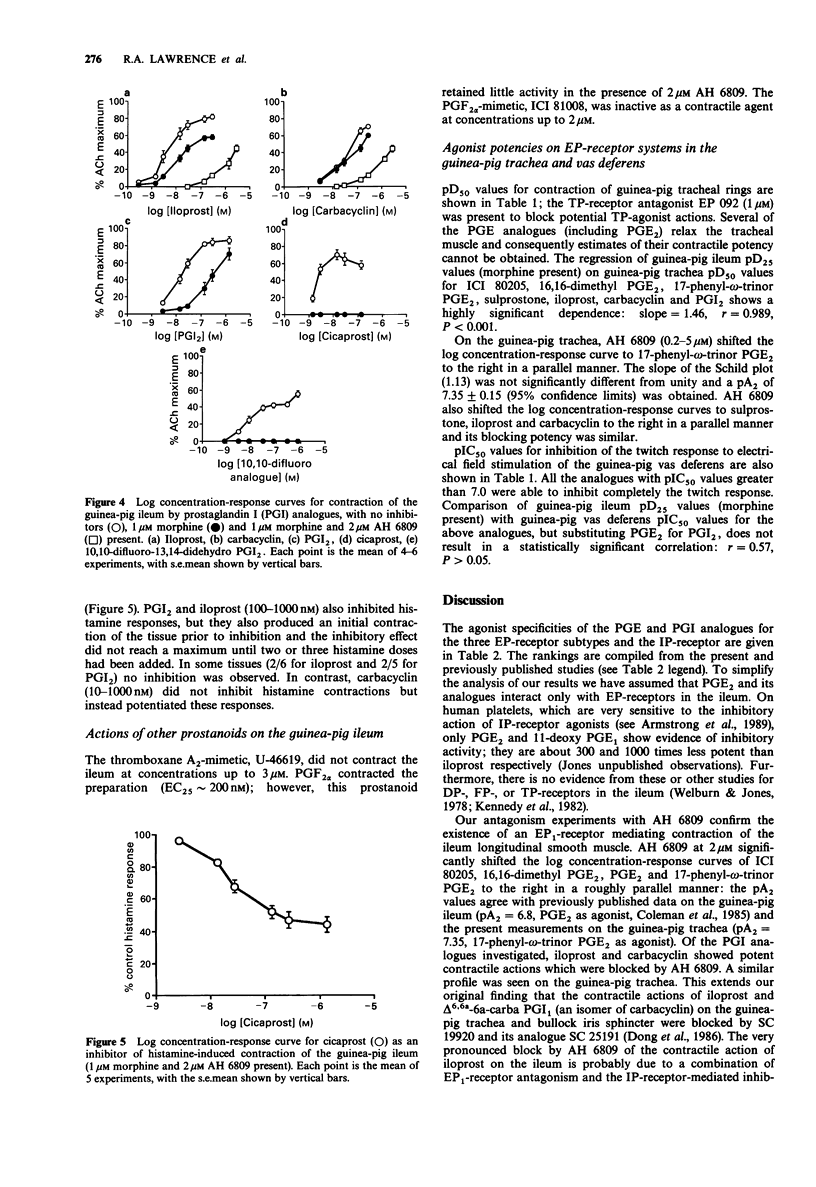Abstract
1. A study of the effects of prostaglandin E2 (PGE2) and eleven synthetic analogues on the guinea-pig isolated ileum preparation has revealed three distinct contractile actions, each associated with a different prostaglandin E (EP-) receptor subtype. In addition, PGI2 (prostacyclin) and its stable analogues can activate prostaglandin I (IP-) receptors to elicit both contraction and relaxation of the ileum. 2. Two of the PGE actions involve direct stimulation of the smooth muscle, being unaffected by 1 microM morphine treatment. One action is blocked by AH 6809 at micromolar concentrations and ICI 80205 and 16,16-dimethyl PGE2 are particularly potent agonists. Activation of EP1-receptors appears to be involved. The second action is unaffected by AH 6809; sulprostone and MB 28767 are potent agonists. Comparison with agonist potency rankings on the guinea-pig vas deferens indicates that EP3-receptors may be involved. 3. The third PGE effect and the stimulant PGI effect are blocked by morphine, indicating enteric neurones and/or sensory nerve terminals as sites of action. EP2-receptors may be involved in the PGE action, in view of the marked effect of morphine on the contractile actions of misoprostol, 11-deoxy PGE2-1-alcohol, 11-deoxy PGE1 and butaprost, all of which show some selectivity for EP2-receptors. The PGI action is most easily studied with cicaprost (EC25 = 1.3 nM), since iloprost, carbacyclin and to a lesser extent PGI2 also have agonist activity at EP1-receptors. 4. The contractile action of 17-phenyl-omega-trinor PGE2 on the ileum is unaffected by morphine.(ABSTRACT TRUNCATED AT 250 WORDS)
Full text
PDF







Selected References
These references are in PubMed. This may not be the complete list of references from this article.
- Armstrong R. A., Lawrence R. A., Jones R. L., Wilson N. H., Collier A. Functional and ligand binding studies suggest heterogeneity of platelet prostacyclin receptors. Br J Pharmacol. 1989 Jul;97(3):657–668. doi: 10.1111/j.1476-5381.1989.tb12001.x. [DOI] [PMC free article] [PubMed] [Google Scholar]
- Bennett A., Eley K. G., Scholes G. B. Effects of prostaglandins E1 and E2 on human, guinea-pig and rat isolated small intestine. Br J Pharmacol. 1968 Nov;34(3):630–638. doi: 10.1111/j.1476-5381.1968.tb08492.x. [DOI] [PMC free article] [PubMed] [Google Scholar]
- Chaki K., Kawamura S., Kisara K., Sakurada S., Sakurada T., Sasaki Y., Sato T., Susuki K. Antinociception and physical dependence produced by [D-Arg2] dermorphin tetrapeptide analogues and morphine in rats. Br J Pharmacol. 1988 Sep;95(1):15–22. doi: 10.1111/j.1476-5381.1988.tb16543.x. [DOI] [PMC free article] [PubMed] [Google Scholar]
- Coleman R. A., Kennedy I., Sheldrick R. L. New evidence with selective agonists and antagonists for the subclassification of PGE2-sensitive (EP) receptors. Adv Prostaglandin Thromboxane Leukot Res. 1987;17A:467–470. [PubMed] [Google Scholar]
- Dong Y. J., Jones R. L. Effects of prostaglandins and thromboxane analogues on bullock and dog iris sphincter preparations. Br J Pharmacol. 1982 May;76(1):149–155. doi: 10.1111/j.1476-5381.1982.tb09200.x. [DOI] [PMC free article] [PubMed] [Google Scholar]
- Dong Y. J., Jones R. L., Wilson N. H. Prostaglandin E receptor subtypes in smooth muscle: agonist activities of stable prostacyclin analogues. Br J Pharmacol. 1986 Jan;87(1):97–107. doi: 10.1111/j.1476-5381.1986.tb10161.x. [DOI] [PMC free article] [PubMed] [Google Scholar]
- Eglen R. M., Whiting R. L. The action of prostanoid receptor agonists and antagonists on smooth muscle and platelets. Br J Pharmacol. 1988 Jun;94(2):591–601. doi: 10.1111/j.1476-5381.1988.tb11565.x. [DOI] [PMC free article] [PubMed] [Google Scholar]
- Fried J., Mitra D. K., Nagarajan M., Mehrotra M. M. 10,10-Difluoro-13-dehydroprostacyclin: a chemically and metabolically stabilized potent prostacyclin. J Med Chem. 1980 Mar;23(3):234–237. doi: 10.1021/jm00177a003. [DOI] [PubMed] [Google Scholar]
- Gaion R. M., Gambarotto L. Target sites for the inhibition of prostacyclin effect in guinea-pig ileum. Naunyn Schmiedebergs Arch Pharmacol. 1987 Oct;336(4):445–452. doi: 10.1007/BF00164881. [DOI] [PubMed] [Google Scholar]
- Gaion R. M., Trento M. The role of adrenergic, purinergic and opiate receptors in the control of prostacyclin-induced contraction in the guinea-pig ileum. Arch Int Pharmacodyn Ther. 1984 Sep;271(1):33–44. [PubMed] [Google Scholar]
- Gaion R. M., Trento M. The role of prostacyclin in modulating cholinergic neurotransmission in guinea-pig ileum. Br J Pharmacol. 1983 Oct;80(2):279–286. doi: 10.1111/j.1476-5381.1983.tb10031.x. [DOI] [PMC free article] [PubMed] [Google Scholar]
- Gardiner P. J. Characterization of prostanoid relaxant/inhibitory receptors (psi) using a highly selective agonist, TR4979. Br J Pharmacol. 1986 Jan;87(1):45–56. doi: 10.1111/j.1476-5381.1986.tb10155.x. [DOI] [PMC free article] [PubMed] [Google Scholar]
- Horton E. W. Biological activities of pure prostaglandins. Experientia. 1965 Mar 15;21(3):113–118. doi: 10.1007/BF02141963. [DOI] [PubMed] [Google Scholar]
- Keery R. J., Lumley P. AH6809, a prostaglandin DP-receptor blocking drug on human platelets. Br J Pharmacol. 1988 Jul;94(3):745–754. doi: 10.1111/j.1476-5381.1988.tb11584.x. [DOI] [PMC free article] [PubMed] [Google Scholar]
- Kennedy I., Coleman R. A., Humphrey P. P., Levy G. P., Lumley P. Studies on the characterisation of prostanoid receptors: a proposed classification. Prostaglandins. 1982 Nov;24(5):667–689. doi: 10.1016/0090-6980(82)90036-3. [DOI] [PubMed] [Google Scholar]
- Lawrence R. A., Jones R. L., Wilson N. H. Relaxant potencies of prostaglandin E analogues on rabbit jugular vein. Br J Pharmacol. 1989 Dec;98 (Suppl):796P–796P. [PubMed] [Google Scholar]
- Sanner J. Prostaglandin inhibition with a dibenzoxazepine hydrazide derivative and morphine. Ann N Y Acad Sci. 1971 Apr 30;180:396–409. doi: 10.1111/j.1749-6632.1971.tb53207.x. [DOI] [PubMed] [Google Scholar]
- Tymkewycz P. M., Jones R. L., Wilson N. H., Marr C. G. Heterogeneity of thromboxane A2 (TP-) receptors: evidence from antagonist but not agonist potency measurements. Br J Pharmacol. 1991 Mar;102(3):607–614. doi: 10.1111/j.1476-5381.1991.tb12220.x. [DOI] [PMC free article] [PubMed] [Google Scholar]
- Welburn P. J., Jones R. L. A comparison of prostaglandin F2alpha and three 16-aryloxy analogues on the isolated rabbit jejunum. Prostaglandins. 1978 Feb;15(2):287–296. doi: 10.1016/0090-6980(78)90168-5. [DOI] [PubMed] [Google Scholar]


